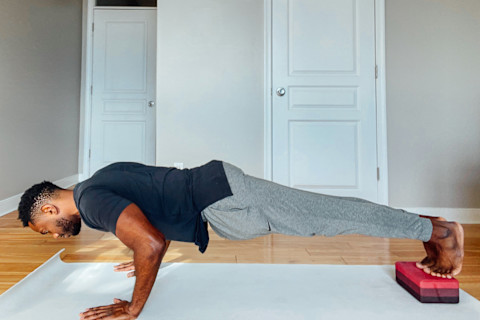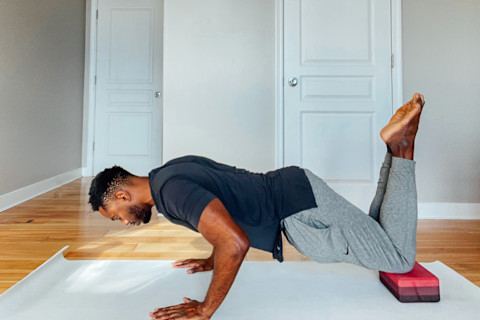How To Do A Decline Pushup To Work Your Upper Body & Core

Pushups are a great standby for working your upper body and core, but if you're looking for something a bit more challenging, you might want to try a decline pushup. It's like a standard pushup, but your feet are elevated, requiring more upper-body strength.
All you'll need is something to put your feet on, like a yoga block, a chair or bench, or even an exercise ball. Here's how to do it, according to certified personal trainer and meditation coach Jason Williams, NASM-CPT.
How to do a decline pushup:

- Begin on your hands and knees, with hands a little wider than shoulder-width apart.
- Place both feet on an elevated surface (like a yoga block, bench, or chair).
- Find your alignment, engaging the core and back of the legs, keeping the body in one straight line.
- Slowly lower yourself, keeping form, with your back as straight as possible.
- Gaze up slightly, but don't arch your back.
- Push yourself back up until arms are straight but elbows aren't locked.
- Perform as many pushups as you can while maintaining proper form.
What are the benefits?
Stand-alone pushups target the upper body and core, and by adding the decline, you're creating even more of a challenge.
Muscles that decline pushups target
According to Williams, decline pushups primarily target the upper pectoralis, shoulders, and triceps. "The benefits of decline pushups are to increase upper body and core strength," he notes. However, with proper form, you're effectively working your full body, including chest, shoulders, back, arms, core, and legs.
And depending on the height of whatever your feet are on, you'll work different chest and shoulder muscles. For example, a higher bench will work the clavicular head of the pectoralis major, while a lower bench works the sternal head of the pectoralis major.
What makes decline pushups different?
With your upper body lower than the legs, there's more weight distributed in your chest and arms, which are doing much of the work here. In short, the greater the decline, the more challenging the pushup.
Common mistakes and risks to keep in mind
As Williams explains, "The most common mistake when doing decline pushups is swaying the lower back." There can be a tendency to sink into the hips and lower back here, so making sure to hug the core in, activate the back of the legs, and keep that spine straight will keep the pressure off the low back.
In addition to that, don't place your hands too wide, as it can limit your range of motion and cause shoulder injuries. Slightly wider than shoulder-width will do.
Decline pushup variations
If you want to make it harder:
The best way to make a decline pushup harder is to increase the height of your feet. For an extra challenge, you could also try using an exercise ball, to work your balance, too. If you do go for the exercise ball, just be careful to mind your form to protect the lower back.
If you want to make it easier:

To make it easier, Williams says you can start on a small block or one step on the stairs. You can also place your knees on a block, if you're still working on strengthening your pushup form.
The takeaway
There's a reason pushups are a standby move in everyone's fitness wheelhouse. They're simple yet effective and easy to modify as needed. If you're looking for a challenge, adding some decline pushups to your next arm workout is a great way to work the upper body.
